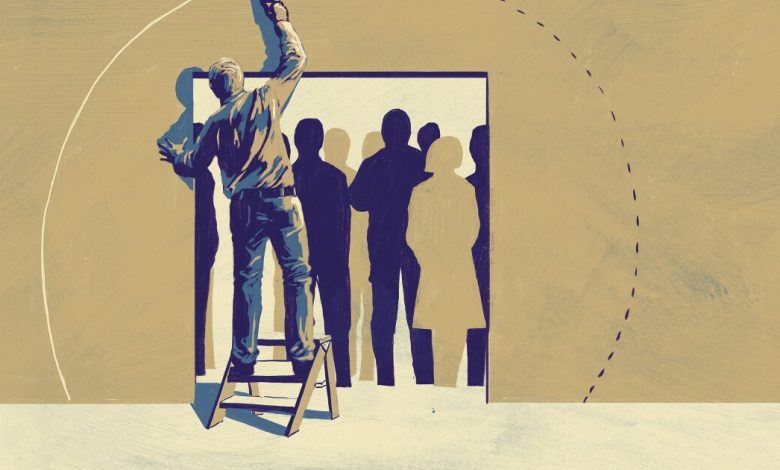Rethinking the Act of Applying to College

On Thursday, the Coalition for College, a membership group of 162 institutions with a shared online application, announced a plan to ease the challenge of applying. As part of a new partnership, the organization will embed its application process into Scoir, an online college-advising platform used by students at more than 2,000 high schools nationwide.
Instead of creating a Coalition application and typing information into a separate website, students with a Scoir account will soon be able to apply to any Coalition college by transmitting an admission form prepopulated with information — demographic data, grades, test scores, and so on — that would already reside under the same virtual roof.
“Our goal,” Stacey Kostell, the Coalition’s chief executive, told The Chronicle last week, “is that everything could be done in one place, with more of it happening in an automated way, so that applying is more seamless.”
The Coalition’s plan is among the latest examples of how the traditional definition of an admission application is evolving. The Common Application, several colleges, and a handful of states are experimenting with various strategies that redefine the act of applying to college. Though there’s no silver bullet that can solve the nation’s college-access challenges, some new approaches have shown promise. And there’s growing support for a key idea: A tedious process that puts the onus on students from start to finish needs an overhaul.
Kostell, a former vice president for enrollment management at the University of Vermont, hopes that the Coalition’s new approach will get more underrepresented students to college. Scoir provides its platform at no charge to high schools eligible for Title I funding (meaning students from low-income families make up at least 40 percent of enrollment); more than 400,000 students attending such schools already use the platform. (Students without a Scoir account can create one for free.)
To make the new process work, the Coalition and Scoir will partner with Technolutions, the company behind Slate, an enrollment-management platform used by more than 1,500 colleges. Integrating Scoir and Slate, Kostell says, will enable a smooth transfer of application materials to colleges and provide member institutions with new ways to communicate with applicants, like providing them with more-robust information about paying for college.
The application system, scheduled to go live this summer, wouldn’t fully automate the admissions process. Depending on where students apply, they might have to upload additional elements, such as supplemental essays and answers to questions about school disciplinary action. But the system would, Kostell says, reduce “portal fatigue” among applicants by reducing the number of websites they must log in to to assemble their application.
The system’s designers want it to be the single-sign-on TurboTax of admissions. “Without doing anything except updating your profile throughout high school,” says Gerry McCrory, Scoir’s founder and chief executive, “you could have maybe 70 to 80 percent of your application ready to go by the time you come to applying to college. The world doesn’t need another application. It just needs a better process.”
Last March, the Common Application, which runs an online admissions application platform used by nearly 1,000 colleges, started a direct-admission pilot program with three historically Black colleges and universities, in Maryland, Tennessee, and Virginia. Approximately 3,300 high-school seniors in those states who had created a Common App account and provided enough academic information were selected for guaranteed admission.
All of those students had at least a 3.0 grade-point average. None had applied to any of the pilot institutions; nearly a third hadn’t applied to a single Common App college.
Each of the 3,300 students received a joint email from the Common App and the HBCU in their state. Students in Maryland received a message that said, “Congratulations! Based on the academic information you entered in your Common App account, you have been selected for admission to the University of Maryland-Eastern Shore” via the direct-admission program: “We have reserved a spot for you at UMES, and it’s now up to you to decide if you want to accept this opportunity.”
The experiment was meant to give students “more agency” in the process, says Jenny Rickard, the Common App’s president and chief executive. “We know that there can be psychological and social barriers for low-income and underrepresented students applying to college. They might start an application but then not submit one because they might fear rejection.”
Ultimately, 66 students responded to the offer by completing a Common App for one of the participating colleges to claim their spot. And eight of those students ended up enrolling at one of the HBCUs.
“Those are small numbers,” says Rickard, who previously led enrollment divisions at two private colleges. “But a 12-percent yield on a cold call in March is pretty incredible.”

Pat Kinsella for The Chronicle
The Common Application is continuing the pilot in the 2021-22 admissions cycle, this time with six institutions, including George Mason University and Montclair State University. Recently, the organization and participating colleges reached out to more than 18,000 students who met a specific GPA minimum, inviting them to submit an application to one of the participating colleges. Within two days, 230 of those students had applied.
Rickard says the Common Application plans to study the result of this year’s pilot to assess the possibility of scaling it up in the future. “We want to understand what the most-effective forms of outreach to students are,” she says. “And we don’t want students getting direct-admission offers from 300 colleges.”
But Rickard sees potential in upending the traditional process for at least some students. “If you’re 17 or 18 and don’t know anyone who went to college, you might think the odds are stacked against you, that you’re not good enough,” she says. “And then you get a message saying that you’re already admitted.”
The program hinged on data-matching between high schools and colleges. Idaho, where the State Board of education oversees both the K-12 and postsecondary systems, was in an especially good position to track students within its longitudinal-data system. Using a combination of students’ unweighted GPAs, high-school course credits, and ACT or SAT scores, Idaho’s direct-admission program admits students to either all eight state institutions or to a subset of them. After getting a letter prompting them to complete a short form, students can claim their seat at a particular campus.
Chuck Staben, a former president of the University of Idaho, hatched the idea after filling out the institution’s application. “It was slow, clunky, and duplicative,” Staben told the Hechinger Report in 2020. “The application was awful. Why do we make it so hard for students to apply?”
Idaho’s direct-admission system — which a handful of other states have either adopted in some form, or plan to enact soon — was built to serve many aims besides simplifying the application process. Those goals included creating college-going culture; helping students, parents, and schools engage with colleges earlier in the college search; and reversing enrollment decline at state institutions.
It was also meant to send a clear signal to high-school students: College is an option for them. “A lot of people think that students know that they are admissible to college, or that they are qualified for college, but that’s not really the case,” says Taylor K. Odle, a predoctoral fellow at the University of Pennsylvania’s Graduate School of Education. “We’re talking about students who would be admitted to college anyways, but now we’re just telling them that.”
Odle helped conduct the first-ever study of the impacts of a direct-admission program, and he is the co-author of a paper on the findings, which will be published in a forthcoming issue of Research in Higher Education. The research — a deep dive into Idaho’s experiment — yielded some promising conclusions: The direct-admission program increased overall first-time student enrollments across Idaho’s institutions by an estimated 4 to 8 percent per campus (50 to 100 students on average). And that increase was driven almost completely by growth in in-state students, whose enrollments increased by about 8 to 15 percent (80 to 140 students). Those enrollment increases were concentrated among two-year, open-access institutions.
The direct-admission plan was found to have had little or no impact on the enrollment of Pell-eligible students. But Odle cautions that the findings, from an early snapshot of institution-level data, aren’t evidence that a direct-admission programs can’t benefit low-income students. For one thing, the impact of such a program might take several years to fully observe.
And as the forthcoming paper on Idaho explains, direct-admission programs provide students with no other college-going supports. Just because a student gets a guaranteed seat doesn’t mean they won’t encounter what the authors call other “hazards to enrollment,” such as a lack of financial resources: “It is possible that a direct-admission system on its own is enough to promote enrollment levels of students generally,” they write, “but not among low-income students.”
That’s why institutional leaders and policy makers, the authors suggest, should consider layering a direct-admission system with other supports, such as financial aid and fee waivers, that can help students overcome other barriers to enrolling. Doing away with the traditional application might be a good starting point, but it’s not the end of the story.
That was a key line from a report published in January by the National Association for College Admission Counseling and the National Association of Student Financial Aid Administrators. The report, which imagined what the college-application process would look like if racial equity were the main objective, included findings and recommendations drawn from interviews with a panel of admissions and financial-aid experts, as well as students.
“When I put it on a flowchart,” one higher-education official said, “it was overwhelming to see the hurdles that we put up for our students that are coming in.”
“One of the biggest barriers for me,” one student said, “was just accessibility to the application.”
“It’s just assumed that if you really want to go to a great school … you’re just going to commit that time to applying,” another student said. “Think about students who have part-time jobs, who are raising families, or who are taking care of their families. Time is a really, really big barrier.”
To make the admissions process more equitable, the report said, it was time to “radically rethink the concept of the college application so that the burden on the student is minimized.” Then came a call to considering jettisoning the application as higher education has long known it: “In a student-centric system … a student could simply select colleges to which they wish to apply, after which the student’s records would be shared digitally between the sending and receiving institution with little or no additional action required by the student.”
Some admissions leaders involved with the Coalition for College’s new partnership with Scoir and Technolutions think their streamlined application process will fit that description. The outcome of the new partnership will be worth watching. The Coalition, which formed in 2015 with the stated goal of helping more low-income and first-generation students get to college — and to make applying less transactional — is taking a new a tack by linking up with a popular college-planning platform that’s also a potential pipeline to many disadvantaged students.
But let’s not forget: Applying to college isn’t the same as being admitted, and being admitted isn’t the same as ending up with an affordable option. Regardless of the applications colleges use, institutional leaders at selective colleges will continue to decide for themselves how many low-income and underrepresented students to accept, how much financial aid to give them, and where diversity-and-equity priorities fit in among many competing goals.
Let’s also remember that the transmission of applications and zillions of required documents to colleges is a big business. The Coalition for College, which processed about 200,000 applications in 2020-21, is in competition with the Common Application, which, as of January 17, had already processed more than six million applications in the 2021-22 cycle. Though Scoir will continue to provide all of its existing services to high schools and students, it will allow applicants to submit admission applications through its new system only to Coalition colleges. Will that fact encourage more eligible institutions to come aboard?
Leaving aside bottom-line questions, competition can be a good thing. Competition leading to more innovation that might help underrepresented students get through the admissions maze could be a really good thing.
Jennifer A. Delaney, an associate professor of higher education at the University of Illinois at Urbana-Champaign and the co-author of the forthcoming paper on Idaho’s direct-admission program, is advising the Common Application on its direct-admission pilot. Such experiments, she says, invite colleges to think differently about the role and function of an admission office: “It’s a move from search to yield, a way to craft a class that can increase diversity. In a moment of enrollment declines, I think it would be very helpful to have a different way of reaching students.”
After all, ye olde admissions application, with its many wrinkles and layers, was created for a particular kind of applicant above all. One with parents who went to college, helpful guides at school, and the resources that can help them cut through the complexity of the process. As colleges seek to increase access and expand opportunities to first-generation students and those with little or no college know-how, taking a close look at just how much the conventional application process requires is a rational idea.
“We already know a lot of things about students,” Delaney says. “The idea that we are going to make them put the same information into multiple application forms — it’s 2022, we shouldn’t need to do that anymore. Our traditional patterns of using the traditional admissions system and traditional admissions recruiting does leave people out.”
The admissions process we know was built to exclude. The question is how to rebuild it — and who’s really willing to try.
Source link






